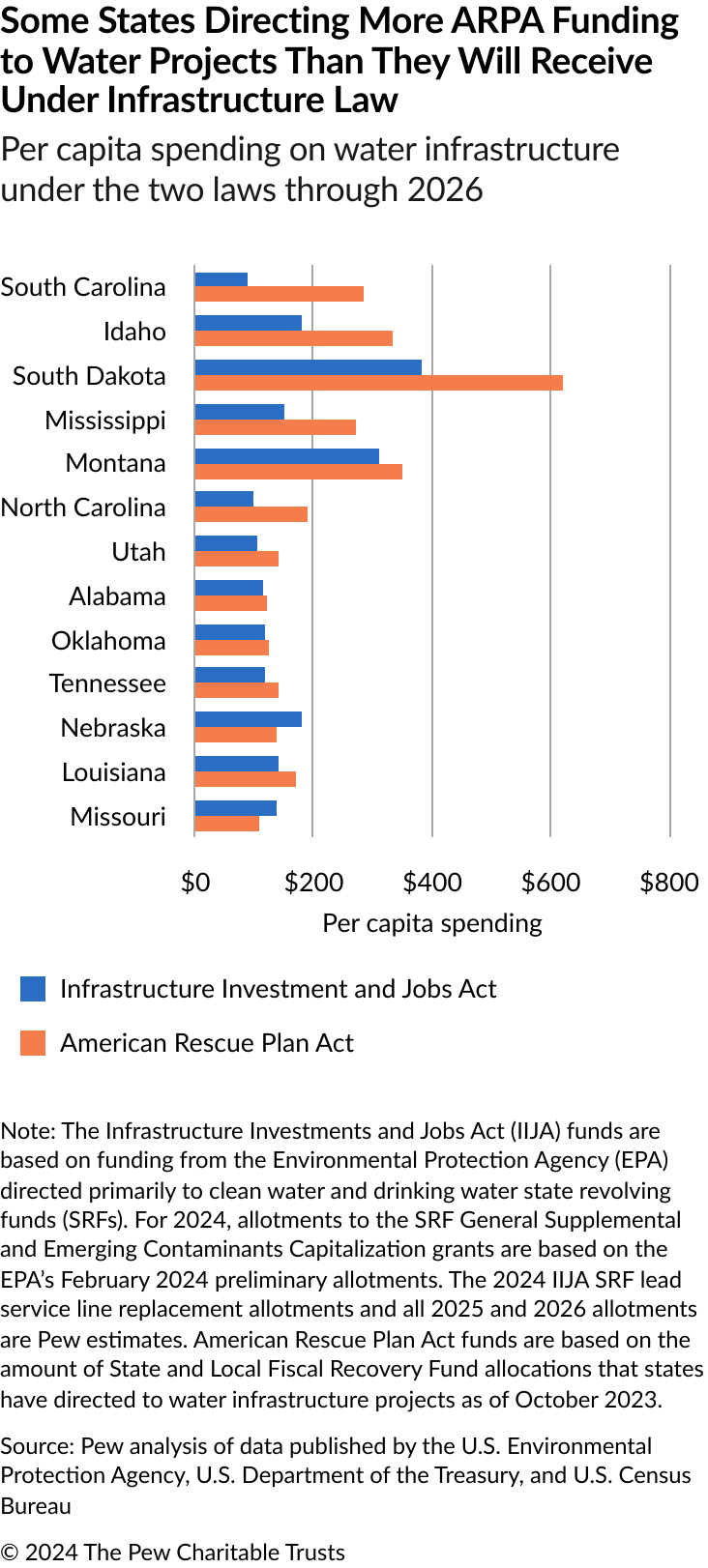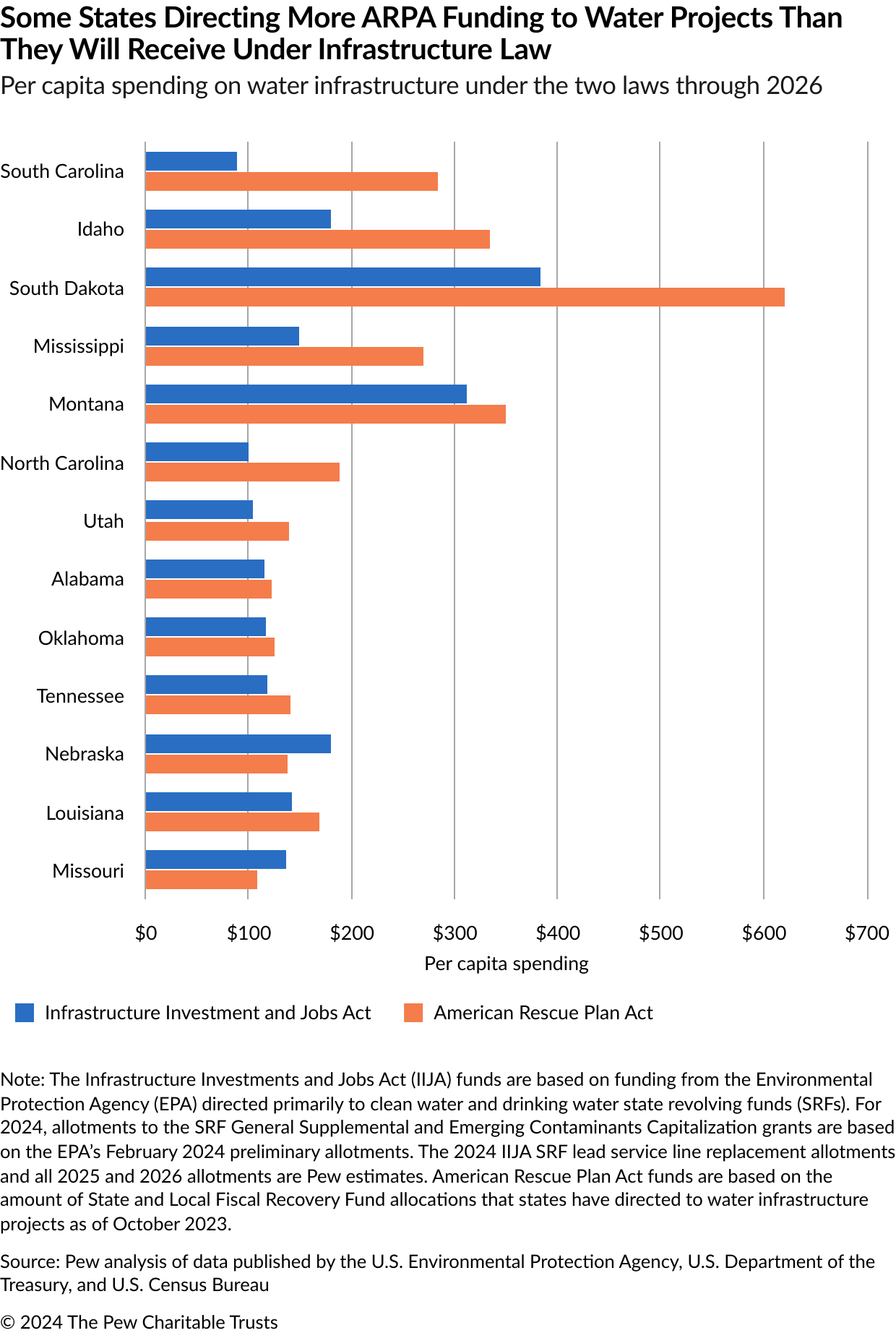How Pandemic Recovery Funds Are Helping States Upgrade Critical Water Infrastructure
Federal dollars offer historic opportunity to repair and replace aging systems

The United States’ water utilities have been underfunded for decades, leaving state and local governments with significant capital needs in the years ahead to repair and replace aging drinking water, wastewater, and stormwater systems. For some states, the American Rescue Plan Act’s (ARPA’s) State and Local Fiscal Recovery Funds (FRF) program is helping to provide a critical down payment toward upgrading their water infrastructure.
Although this federal funding will jump-start important investments nationwide, communities will continue to face significant needs and emerging challenges—such as contaminants that pose public health concerns and climate-related physical threats—that will require ongoing funding even after the ARPA dollars are spent.
Overall, states are spending $20 billion, or 10% of their recovery fund allocations, on water-related infrastructure projects, according to The Pew Charitable Trusts’ analysis of data from the U.S. Department of Treasury. If local government spending is included, that number jumps to more than $25 billion. But spending ranges significantly among states—while some are directing funds to other priorities, 13 have budgeted an estimated 25% or more of their FRF allocations to investments in water infrastructure. That policymakers in these states are choosing to funnel such a significant percentage of discretionary ARPA dollars into water infrastructure indicates the importance to these governments of bolstering water utilities and water management systems.
Note: The map shows state government obligations only as a percentage of total ARPA Fiscal Recovery Fund allocations received by each state. Obligated funds include those reported under the water infrastructure expenditure categories as well as obligations being used for water infrastructure under the revenue replacement expenditure category.
Source: Pew analysis of data published by the U.S. Department of the Treasury
The states directing the most funding to water infrastructure are primarily concentrated in two regions. They are Western states bordering the Rocky Mountains that need to bolster water supplies that have been strained by climate risks and significant population growth, and Southeastern states, where policymakers are focused primarily on serving communities that have experienced long-standing inequities and on addressing public health concerns.
In the West, Idaho has budgeted 60% of its FRF allocation for water, including $300 million in grants to communities and funding for dam and aquifer projects to support the state’s vulnerable groundwater infrastructure. Utah is making significant investments to fund water efficiency and conservation initiatives to address long-standing water supply challenges. Meanwhile, South Dakota and Montana are using their federal allocations to fund grants for water and sewer infrastructure, using population density metrics and other tools to ensure that dollars are targeted to rural communities in both states.
In the Southeast, Alabama has committed more than $600 million in grants for water infrastructure in disadvantaged communities, including $10 million for demonstration grants for wastewater projects targeting unsewered communities in what is known as the state’s Black Belt. In Mississippi, where the Jackson water crisis in 2022 highlighted infrastructure vulnerabilities, the state has committed 44% of FRF allocations for water with a priority on funding for unsewered communities and drinking water projects in rural areas. Other Southern states, such as North Carolina and South Carolina, are investing funds to incentivize inventorying of existing assets, consolidating water utilities, and improving regional coordination across systems to achieve greater economies of scale.
In addition to ARPA, the federal government has provided more than $50 billion in funding for water systems through 2026 under the bipartisan Infrastructure Investments and Jobs Act (IIJA) of 2021. In some states, however, the FRF allocations budgeted for water infrastructure are larger than the estimated funding the states will receive through the IIJA. Looking at the 13 states spending more than 25% of their flexible recovery fund allocations on water infrastructure, 11 will spend more under ARPA than the amount they are expected to receive in water infrastructure-related funding or financing through the IIJA from 2022 to 2026.

Despite the infusion of federal funds from ARPA and IIJA flowing toward drinking water and wastewater infrastructure, state capital and maintenance needs remain high. New mandates around replacing lead service lines and addressing emerging contaminants—along with climate change-related risks around flooding, storms, and drought—make clear that repairing existing and building new water infrastructure will likely remain an important consideration for states and local governments for years to come.
Stephanie Connolly is a principal associate and Aleena Oberthur is a project director with The Pew Charitable Trusts’ state fiscal policy project.















